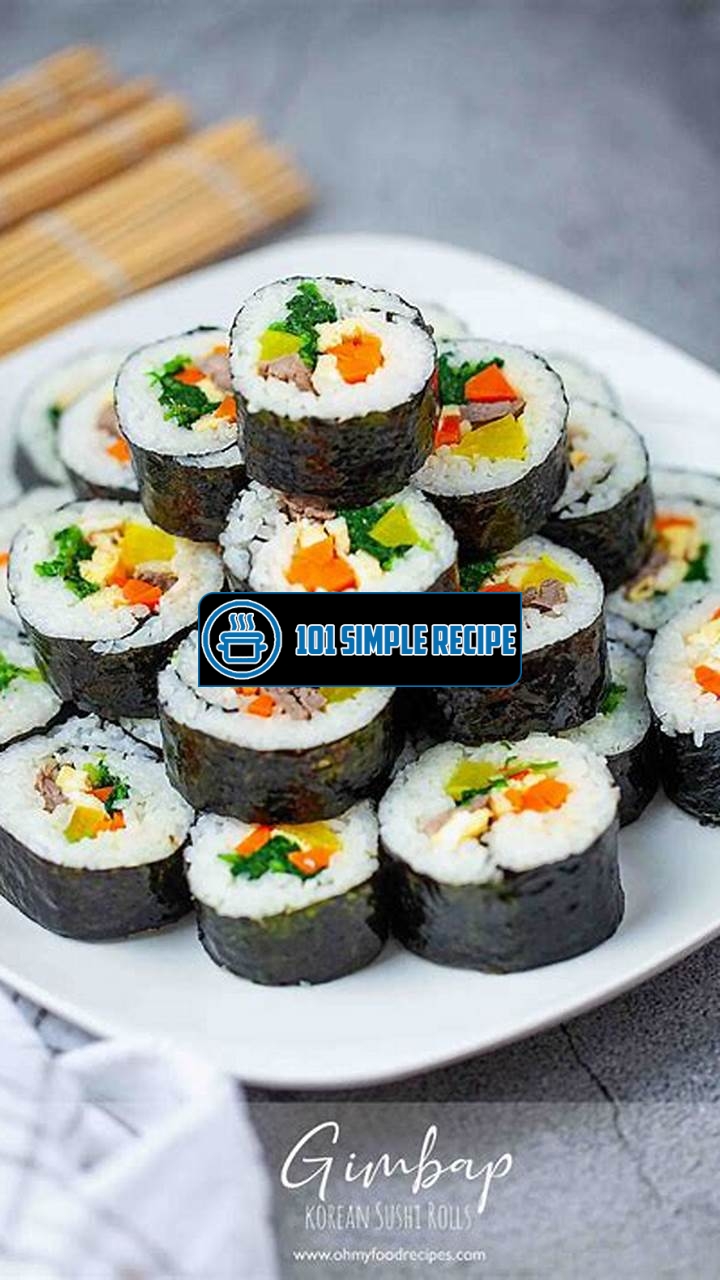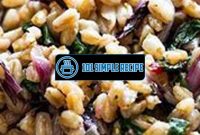Are you looking for a healthy and delicious option for your next meal? Look no further than Kimbap! This traditional Korean dish is not only packed with flavor but also offers numerous health benefits. Kimbap is made with rice, vegetables, and a variety of fillings, such as meat or seafood, all wrapped in a sheet of seaweed. The combination of these ingredients results in a nutritious and satisfying dish that can be enjoyed by everyone. So, is Kimbap a healthy and delicious option? Let’s dive deeper into its nutritional value and taste to find out.

The Health Benefits of Kimbap
Discover the nutritional value of kimbap and how it can contribute to a healthy diet.
A Balanced Combination of Ingredients
Kimbap, a traditional Korean dish, offers a balanced combination of ingredients that make it a healthy and delicious option to include in your diet. This popular dish is made by rolling cooked rice, vegetables, and protein in seaweed sheets. It is often compared to sushi, but the ingredients and flavors are different.
The main ingredients in kimbap include rice, seaweed, vegetables (such as carrots, cucumbers, and spinach), and protein sources like cooked beef, chicken, or fish. The combination of these ingredients provides a balanced mix of carbohydrates, proteins, vitamins, and minerals, making it a nutritious choice.
When you consume kimbap, you benefit from the different nutrient profiles of its ingredients, which work together to promote overall health. The rice in kimbap offers a source of energy and contains essential minerals like magnesium and selenium. The vegetables, on the other hand, provide a variety of vitamins, including vitamin A, vitamin C, and vitamin K.
By including protein sources in kimbap, such as cooked beef or fish, you add another layer of nutritional value. Proteins are the building blocks of our body and play a vital role in maintaining healthy tissues, muscles, and immune function. Additionally, proteins help provide a feeling of satiety and can contribute to weight management.
Packed with Essential Vitamins and Minerals
One of the key reasons why kimbap is a healthy choice is its rich content of essential vitamins and minerals. The variety of vegetables used in kimbap provides a range of vitamins, including:
- Vitamin A: Important for maintaining healthy vision and skin.
- Vitamin C: Essential for a strong immune system and collagen production.
- Vitamin K: Helps with blood clotting and bone health.
These vitamins are crucial for various bodily functions and contribute to overall well-being. By regularly consuming kimbap, you can increase your intake of these essential nutrients and support your body’s daily needs.
Additionally, kimbap contains minerals such as calcium, iron, and potassium. Calcium is necessary for strong bones and teeth, while iron helps transport oxygen in the body. Potassium plays a role in maintaining proper heart function and regulating blood pressure.
A Good Source of Fiber
Incorporating fiber-rich foods into your diet is key for maintaining a healthy digestive system and preventing constipation. Kimbap is an excellent source of fiber due to its vegetable content and the inclusion of whole grains like brown rice.
Fiber adds bulk to your stool, promoting regular bowel movements and preventing digestive issues. It also helps you feel full for longer, making it a beneficial component for weight management. By enjoying kimbap, you can increase your fiber intake and support a healthy gut.
Try including kimbap in your meal rotation to enjoy its health benefits and savor its delicious flavors. This Korean dish provides a balanced combination of ingredients, essential vitamins and minerals, and a good dose of fiber, making it a healthy and enjoyable addition to your diet.
Potential Health Concerns
Kimbap, a traditional Korean dish, is often touted as a healthy and delicious option for a meal or snack. However, like any food, it is important to consider its potential drawbacks and how to mitigate them. In this article, we will explore some of the possible health concerns associated with consuming kimbap and provide tips on how to address them.
Sodium Content and Blood Pressure
One potential health concern when it comes to kimbap is its sodium content. Kimbap typically contains soy sauce, which is high in sodium. Excessive sodium consumption can contribute to high blood pressure, a risk factor for various health issues such as heart disease and stroke.
To mitigate this concern, there are a few steps you can take. First, when making kimbap at home, consider reducing the amount of soy sauce used or opting for a low-sodium version. Additionally, you can incorporate more fresh vegetables, such as cucumbers and carrots, to add flavor and reduce the need for excessive sodium.
Avoiding the usage of processed meats, such as ham or spam, in your kimbap can also help in reducing the overall sodium content. Instead, you can opt for lean protein options like grilled chicken or tofu to keep your kimbap both tasty and healthy.
Potential Weight Gain
Another concern to keep in mind is the potential for weight gain associated with consuming kimbap. While kimbap can be a nutritious meal choice, it is important to be mindful of portion sizes and the ingredients used.
Kimbap can be quite filling due to its content of rice and various fillings. However, if you regularly consume large portions or consume it in addition to other high-calorie foods, it can contribute to weight gain over time.
To address this concern, practice portion control by enjoying a moderate-sized kimbap roll as a meal or snack. Pair it with a side of fresh fruits or a small salad to increase the overall nutrient density of your meal. By incorporating a balanced diet and regular exercise, you can enjoy kimbap as part of a healthy eating plan without worrying about weight gain.
Allergies and Sensitivities
Lastly, it is important to consider potential allergies and sensitivities when consuming kimbap. Some ingredients commonly used in kimbap, such as shellfish or gluten-containing soy sauce, can trigger allergic reactions or cause discomfort in individuals with sensitivities.
If you have known allergies or sensitivities, make sure to check the ingredients used in the kimbap or opt for homemade versions where you have control over the ingredients. You can substitute certain ingredients to accommodate your needs or explore alternative fillings that suit your dietary restrictions.
Overall, kimbap can be a healthy and delicious option when consumed in moderation and with attention to potential health concerns. By being mindful of the sodium content, portion sizes, and individual allergies or sensitivities, you can enjoy this traditional Korean dish as part of a balanced diet. Bon appétit!
Healthier Variations of Kimbap
When it comes to enjoying delicious Korean cuisine, kimbap is a popular choice. This traditional dish is often mentioned in the same breath as sushi, thanks to its similar appearance. However, kimbap offers its own unique flavors and ingredients that set it apart.
If you’re wondering whether kimbap is a healthy option, the answer is a resounding yes! But did you know that you can make it even healthier by exploring alternative ingredients and cooking methods? In this article, we’ll delve into some exciting ways to enhance the nutritional value of your kimbap.
Using Whole Grain Rice
Rice is a staple in kimbap, but opting for whole grain rice instead of white rice can significantly boost its health benefits. Whole grain rice retains the bran and germ layers, which are packed with essential nutrients, fiber, and antioxidants. This increases the overall nutritional value of your kimbap.
In addition, whole grain rice has a lower glycemic index, meaning it doesn’t cause a rapid spike in blood sugar levels. This makes it an excellent choice for individuals looking to manage their blood sugar levels or maintain a healthy weight.
Try using whole grain rice in your kimbap to reap its nutritional benefits and promote better blood sugar control.
Adding More Vegetables
Another way to make your kimbap healthier is by adding an array of colorful and nutrient-packed vegetables. Not only do vegetables enhance the taste and texture of your rolls, but they also provide a host of health benefits.
Consider including vegetables such as carrot, cucumber, spinach, and avocado in your kimbap. These veggies are rich in vitamins, minerals, and fiber, all of which contribute to a well-rounded and nutritious meal. Plus, they add vibrant colors that make your kimbap visually appealing.
Boost the nutritional value of your kimbap by incorporating a variety of vegetables, making it a wholesome and colorful delight.
Exploring Vegan or Vegetarian Options
If you’re following a vegan or vegetarian lifestyle, you’ll be pleased to know that kimbap can easily be adapted to suit your dietary preferences. Instead of traditional fillings like meat or fish, experiment with plant-based alternatives.
For instance, you can replace the meat with tofu or tempeh, which are excellent sources of protein. Additionally, consider using vegan-friendly condiments like soy sauce or tamari to enhance the flavors of your kimbap.
Embrace the versatility of kimbap by exploring vegan or vegetarian options, which offer a nutritious and cruelty-free twist on this Korean classic.
To conclude, kimbap is not only a delicious dish but also a healthy one. By incorporating whole grain rice, adding more vegetables, and exploring vegan or vegetarian options, you can elevate the nutritional value of your kimbap without sacrificing taste. So go ahead and enjoy this flavorful Korean delight knowing that it’s both healthy and delightful!
Incorporating Kimbap into a Balanced Diet
Find out how kimbap can fit into a well-rounded and nutritious eating plan.
Portion Control
When it comes to incorporating kimbap into a balanced diet, portion control is key. Kimbap is a delicious Korean dish consisting of rice, vegetables, and often meat or seafood wrapped in sheets of seaweed. While it can be a healthy option, it’s important to enjoy it in moderation.
One serving of kimbap typically contains around 200-300 calories, depending on the ingredients used and the size of each roll. It’s best to aim for one roll as a serving size and pair it with other nutrient-rich foods to create a balanced meal.
By practicing portion control, you can still enjoy the flavors of kimbap while maintaining a healthy calorie intake.
Pairing Kimbap with Other Nutrient-Rich Foods
For a well-rounded and nutritious meal, consider pairing your kimbap with other nutrient-rich foods. Adding a side of fresh salad or steamed vegetables can increase the overall fiber and nutrient content of your meal. Additionally, including a serving of lean protein such as grilled chicken or tofu can provide additional satiety and help balance the meal.
Another great option is to enjoy kimbap with a bowl of miso soup. Miso soup is a traditional Japanese soup made from fermented soybeans and is known for its health benefits. It’s low in calories and rich in nutrients, making it a perfect accompaniment to kimbap.
By pairing kimbap with other nutrient-rich foods, you can create a well-balanced meal that provides a variety of essential vitamins, minerals, and macronutrients.
Making Kimbap part of a Weekly Meal Plan
If you’re a fan of kimbap, consider making it part of your weekly meal plan. By preparing kimbap at home, you have control over the ingredients used and can customize it to fit your preferences and dietary needs.
To make your homemade kimbap even healthier, opt for brown rice instead of white rice. Brown rice is a whole grain and contains more fiber and nutrients than its refined counterpart.
You can also experiment with different fillings and variations to keep your kimbap meals interesting. Try incorporating fresh vegetables like carrots, cucumbers, or spinach for added nutrients and crunch.
By including kimbap as part of your weekly meal plan, you can enjoy this delicious dish while still maintaining a nutritious eating plan.
Note: It’s important to remember that while kimbap can be a healthy and delicious option, it’s always best to listen to your body and enjoy everything in moderation. Each individual may have different dietary needs and preferences, so it’s essential to personalize your eating plan accordingly.
In conclusion, incorporating kimbap into a well-rounded and nutritious eating plan is definitely possible. By practicing portion control, pairing it with other nutrient-rich foods, and making it part of a weekly meal plan, you can enjoy the flavors of kimbap while nourishing your body with essential nutrients. Remember to always listen to your body and make choices that align with your individual needs and preferences.
Healthy Alternatives to Kimbap
When it comes to Korean cuisine, kimbap is a popular choice. Packed with flavorful ingredients wrapped in seaweed and rice, it offers a delicious and satisfying eating experience. But is kimbap a healthy option? Let’s explore some alternatives that not only provide similar flavors and textures but also offer added health benefits.
Bibimbap: A Nutrient-Rich Rice Bowl
If you are looking for a nutrient-packed alternative to kimbap, bibimbap is the perfect choice. This colorful rice bowl is filled with an assortment of fresh vegetables, lean protein, and a sunny-side-up egg. It provides a balanced combination of carbohydrates, proteins, and healthy fats, ensuring you get all the necessary nutrients for a well-rounded meal.
Bibimbap offers a variety of textures and flavors, from crunchy bean sprouts to tender mushrooms. The vibrant mix of vegetables not only adds visual appeal to the dish but also provides an array of vitamins, minerals, and antioxidants. The addition of a perfectly cooked egg adds a creamy richness to the bowl, making it even more satisfying.
Gimbap: The Lighter Version of Kimbap
If you enjoy the taste of kimbap but want a lighter option, gimbap is the way to go. While both dishes have a similar appearance, gimbap is typically made with less oil and fewer ingredients. This makes it a healthier choice for those who are watching their calorie intake or trying to maintain a balanced diet.
Gimbap consists of rice, vegetables, and protein (usually cooked fish or pickled radish) rolled in seaweed. It is a low-fat, low-sodium alternative that still packs a flavorful punch. The fresh vegetables provide a dose of vitamins and minerals, while the fish adds protein and essential omega-3 fatty acids. It’s a satisfying option that won’t leave you feeling weighed down.
Kimchi: A Probiotic Powerhouse
If you are looking for a healthy side dish to complement your meal, kimchi is the way to go. This traditional Korean fermented cabbage is not only delicious but also offers a wide range of health benefits. Kimchi is a probiotic powerhouse, packed with beneficial bacteria that promote gut health and digestion.
️
Kimchi is made by fermenting cabbage with a variety of seasonings, including red chili pepper flakes, garlic, and ginger. This process not only enhances the flavor but also increases the nutritional value of the cabbage. It is rich in vitamins A, B, and C, as well as iron and fiber. The spicy kick of kimchi adds a burst of flavor to any meal and can be enjoyed as a side dish or added to soups, stews, and rice bowls.
Overall, there are plenty of healthy alternatives to kimbap that offer similar flavors and textures while providing additional health benefits. From the nutrient-rich bibimbap to the lighter gimbap and the probiotic powerhouse kimchi, these Korean dishes are sure to satisfy your cravings while keeping your health in mind.
Frequently Asked Questions
Below are some frequently asked questions about the healthiness of kimbap:
| No. | Questions | Answers |
|---|---|---|
| 1. | Is kimbap a healthy food option? | Yes, kimbap can be a healthy food option as it includes a variety of vegetables and lean protein. However, it’s important to pay attention to the ingredients and portion sizes to ensure a balanced meal. |
| 2. | What are the nutritional benefits of kimbap? | Kimbap is rich in nutrients such as fiber, vitamins, and minerals. It provides a good source of carbohydrates, proteins, and healthy fats, making it a well-rounded meal option. |
| 3. | Can kimbap fit into a balanced diet? | Yes, kimbap can fit into a balanced diet when consumed in moderation. It’s important to pair it with other nutritious foods and maintain a varied diet to meet all your nutritional needs. |
| 4. | Are there any potential downsides to eating kimbap? | While kimbap can be a healthy choice, it’s important to be mindful of the sodium content, especially if you have high blood pressure. Additionally, if you have specific dietary restrictions or allergies, it’s important to check the ingredients before consuming. |
| 5. | What are some healthier alternatives to traditional kimbap fillings? | If you are looking for healthier alternatives, you can try using brown rice instead of white rice, adding more vegetables like spinach or kale, and choosing leaner protein options such as grilled chicken or tofu. |
| 6. | Can kimbap be part of a weight loss plan? | Kimbap can be part of a weight loss plan if consumed in moderation and as part of a balanced diet. However, it’s important to keep track of the portion sizes and overall calorie intake to ensure it aligns with your weight loss goals. |
Thank You for Reading!
We hope this article has provided you with valuable information about the healthiness of kimbap. Remember to always make informed choices based on your individual needs and preferences. If you have any more questions or want to learn more, feel free to visit us again later. Happy eating!
Jump to Recipe
Is Kimbap Healthy?

Discover the health benefits of kimbap and learn how it can fit into a balanced diet. Find out about potential downsides and healthier alternatives.
- 4 cups cooked white rice
- 4 sheets of seaweed (gim)
- 8 ounces cooked beef or chicken strips
- 1 cucumber (julienned)
- 2 medium carrots (julienned)
- 4 eggs (beaten and cooked into thin omelettes)
- 2 tablespoons sesame oil
- 2 tablespoons soy sauce
- 1 teaspoon sugar
- salt and pepper to taste
- Cook the rice according to package instructions and let it cool.
- In a bowl, combine the cooked beef or chicken strips, cucumber, carrots, sesame oil, soy sauce, sugar, salt, and pepper. Mix well.
- Place one sheet of seaweed on a bamboo sushi mat. Spread a thin layer of rice evenly over the seaweed, leaving a small border at the top. Add a strip of omelette, followed by a strip of the filling mixture. Roll the kimbap tightly using the bamboo mat, applying gentle pressure.
- Once rolled, remove the kimbap from the bamboo mat and slice it into bite-sized pieces using a sharp knife.
- Arrange the sliced kimbap on a platter and serve it with soy sauce or other dipping sauces of your choice. Enjoy!






